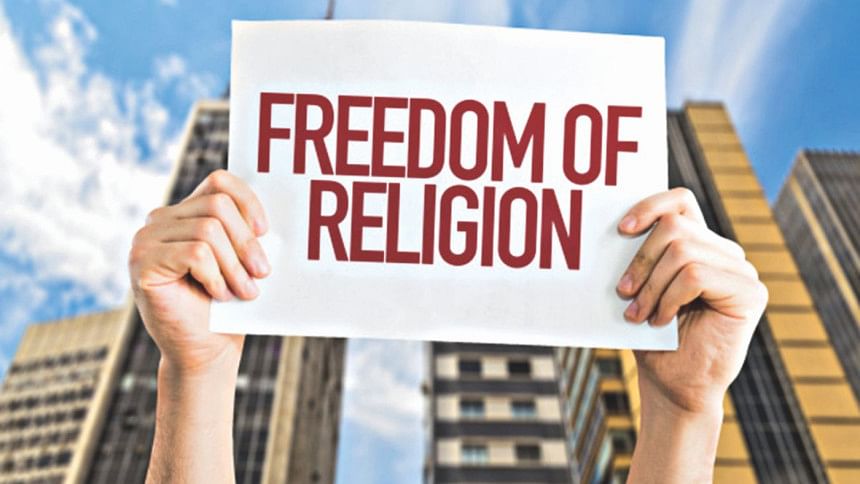AN ASPECT OF FREEDOM OF RELIGION

Article 39 of the Constitution guarantees freedom of thought, conscience and expression. Freedom of expression ranges from the articulation of words and images to actions and lifestyle choices, including one's manner of dress and behavior. Subjecting a woman to harassment due on account of her failure to maintain a particular dress code is a discriminatory act, which is a violation of equality clauses of the Constitution and is inconsistent with international standards.” The foregoing sentences were verbatim opined in the case Advocate Md. Salauddin v Bangladesh (63 DLR 2011, para 14). According to the Court, alongside right to freedom of expression, arbitrary and intrusive gender based codes for acceptable demeanour and dress also violate right to privacy and personal liberty as well as rights of women to protection from violence (para 15). The case emanated from some sexually coloured remarks passed by an Upazilla Education Officer and a direction given by him towards the female teachers to attend school thenceforth wearing a scarf. The decision can no way be said to be discouraging towards wearing of veil or covering of head, rather it leaves it entirely to the choice of the women, marking thereby a commendable baby step forward.
Imposition of dress code certainly is a violation of personal liberty and freedom of expression (Article 39); however, it inspires (rather incites) a discussion from another aspect. While backing the ban on headscarves at workplaces, in G4S v Achbita and Bougnaoui (2017), the Court of Justice of European Union found that since G4S's internal rule refers to the wearing of visible signs of political, philosophical or religious beliefs and therefore covers any manifestation of such beliefs without distinction, it in fact treats all the employees in the undertaking in the same way without differentiation.
Therefore, the Court opined that there was no direct discrimination. Inasmuch as indirect discrimination is concerned, (Indirect discrimination occurs when an organisation's apparently neutral policy, rule or procedure affects everyone but has a worse or more adverse impact on a particular group for its protected characteristics which may include sex, race, religion or sexual orientation), the court opined that since the aim was 'legitimate', the rule was justified. It further observed that imposition of the rule was an expression of G4S's 'freedom to conduct business'. This, in my understanding, is a crippled argument propounded in order to 'objectively' (!) justify the ban. It did not show as to how freedom to conduct business supersedes the human right to freedom of religion.
There remains diametrically opposite judgments given by the European Court of Human Rights which have previously ruled on how freedom of religion applies in the workplace, concluding that in some cases, employers must allow employees who wish to wear religious symbols (Eweida v UK (2013), for an example) to do so; and imposition of sanctions which might look neutral, might in fact be indirect discrimination on ground of religion. No reference of the ECtHR judgments in the ECJ judgment, in fact, added another layer of confusion. Insistence upon dress codes have been seen as indirect discrimination on ground of religion in numerous instances. In the Canadian case of Singh v Security and Investigation Services Ltd (1987), a Sikh man was refused a job as a security guard because of requirements that incumbents be clean shaven and wear a uniform that includes hat.
In Bhinder and Canadian Human Rights Commission v Canadian National Railway Co (1985), the employer imposed a condition that all people working in the place wear hard hats. In these two cases, sikhs were found to be victims of indirect discrimination on the ground of religion. In Eg Kingston & Richmond Area Health Authority v Kaur (1981), demanding that women employees wear skirts or forbidding them to wear trousers was found to be a requirement with which, the Muslim women will not practically be able to comply.
Usually, banning of headscarf, as a sanction, (unlike our domestic case) attracts 'indirect discrimination' because the sanction touches the men as well (all employees are required to keep their heads uncovered). In the present case, there was no need to go in search for indirect sex discrimination because there remained no neutral policy touching men and women both; rather a sanction was imposed on the women only, that too being accompanied by some sexually coloured remarks. However, what remained unseen beyond the apparent was the aspect of freedom of religion. For both Muslim and non-Muslim women, such a sanction, if imposed, would have an impact; but those women, who, for their individual beliefs or religion, prefer to avoid wearing headscarves, would be the ones being adversely affected because of their protected characteristic, i.e. religion or belief. Such sanctions therefore are direct sex discrimination (when imposed the way it has been in the present case) and among the women, an indirect discrimination on ground of religion against a portion thereof.
Banning of headscarves easily gets associated with freedom of religion since the victims happen to form part of the religious minority in those contexts and since the bans in fact are in consonance with the majority's belief. Imposition of the same should also be seen through the specs of freedom of religion in contexts where the imposition is similarly in consonance with the majority's belief because the religious aspect of headscarves is not something we can keep aside and inasmuch as 'banning' thereof affects the freedom of religion or belief of a particular group, 'imposition' thereof affects the same of another.
One might frown saying that the present case is distinguishable from the others cited above for not concerning a written policy, rather a sanction, only orally imposed (this, in turn, can even unknowingly initiate another distinctly different discourse by questioning the standing of the petitioner and encouraging another stream of arguments for showing as to how a Government official or public servant's statements amounting to oral sanctions can be attributable to the State). Since the admissibility was and remained unchallenged, with hindsight, my observation starts from a few steps through the judgment. The directives given towards the Ministry of Education in fact shows that the Court foresaw and encompassed other situations (which might concern written policies) with factual overtones and undertones, within the decision. One might further argue that seeing the aspect of freedom of religion was not at all required. However, since several other Articles of the Constitution were invoked, invocation of Article 41 doesn't really seem to be too farfetched.
This was an opportunity for analysing in detail as to how imposing such a sanction violates a woman's freedom of religion too and how it can be, in some cases, an indirect discrimination on ground of religion (besides freedom of expression, personal liberty and privacy). Honorable Court did enter into the valley in Salauddin Dolon case; however, it completed its journey only partially!
The writer works with Law Desk, The Daily star.

 For all latest news, follow The Daily Star's Google News channel.
For all latest news, follow The Daily Star's Google News channel. 



Comments